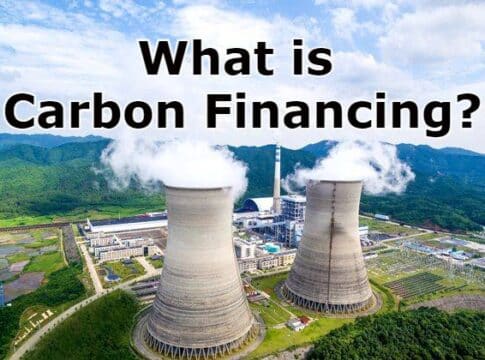What is Carbon Financing?
In the simplest sense, financing is the process of putting money to entities or activities that most need them or can put them to the most productive use. While there are all sorts of financing for personal or business use, there’s one type that often makes head turns.
Carbon financing.
You may also be raising your eyebrows if it’s the first time you to hear it or if you want to know more about it. There’s no need to wonder about it though because this article will explore carbon financing.
It will help you know the tools of this financing and walk you through the world of carbon credits and carbon markets. You’ll also learn how the government and the private sector works under a carbon financing scheme. Then you’ll get to discover how you can also partake in this exciting space of carbon.
What is Carbon Financing?
Carbon finance supports an asset that’s the main culprit of global warming and climate change – carbon dioxide or its equivalent. Its sole purpose is to reduce global carbon emissions by offering opportunities to mitigate the effects of climate change through emissions reduction projects.
Carbon financing creates climate systems that make it possible to measure carbon and incentivizes both firms and individuals to reduce their carbon footprint. It often takes the form of annual payment to a project partner, be it an NGO, private, or public entity, for the emission reductions delivered by the project.
The emission reductions are typically measured in tonnes of carbon dioxide equivalent (tCO2e) and are represented by carbon credits. One carbon credit is equal to 1 tonne of tCO2e removed or avoided.
As such, carbon financing improves the financial viability of projects while creating additional revenue streams for developers and beneficiaries. It also enables the transfer of technologies and knowledge in the industry.
Best of all, carbon finance provides various means to leverage investments in projects that reduce GHG emissions in countries where they’re most viable. All the while helping the world to transition to a low-carbon economy.
But what makes this kind of financing possible and feasible? A carbon bank.
What is a Carbon Bank?
Carbon financing can only be effective in spurring the transition if the challenges associated with it are addressed. This is where the role of a carbon bank comes into play.
A carbon bank is an independent entity, free from political influence, responsible for oversight and management of the carbon market.
It seeks to sustain confidence in the system and ensure compliance by managing and minimizing carbon pricing volatility. It can choose how to manage the price, using some of the cost-containment mechanisms available.
A carbon bank can also help tackle some of the underlying factors of price volatility, such as market expectations and investor activities. Plus, it can also react to volatility due to external drivers like fuel prices and weather conditions.
The bank will not only be charged with price management, but would perform a range of market oversight and management functions. These include:
Professional forecasting: judgments or assessments with regards to emissions and carbon prices
Allowance management: allocating and tracking allowances as well as conducting auctions
Monitoring emissions: ensuring compliance and evaluating progress towards emissions reductions
Cost containment: buying and selling allowances and approving offset projects
Coordinating with different government bodies
Many jurisdictions, including Australia, Canada, and the United States, have explored the possibility of using a carbon bank as a potential tool to manage their carbon pricing as part of the overall policy objectives of the government.
What Are the Tools of Carbon Financing?
While there are a range of tools of carbon finance, the creation or allowance of carbon credits that can be traded in compliance or voluntary carbon markets, has been the top option.
That could be because this kind of financial mechanism places value on the reduction of carbon itself, which makes it a tradable asset. Turning emission reductions into carbon credits that can be traded in various exchanges and markets help stimulate the economy as the world fights climate change.
For carbon finance to work, carbon credits are essential. So, let’s dig deeper into this carbon financing tool and the markets the credits trade.
What Are Carbon Credits and How Are They Created?
Carbon credits are tradable assets that represent one tonne of carbon avoided/removed from the atmosphere.
They are created through projects that reduce carbon emissions. These projects vary a lot, from nature-based solutions to carbon removal technologies.
The types of carbon credits also vary, depending on what project creates them. So far, there are 170+ types of credits available in the market.
There are two ways to produce these credits:
Development and operation of projects that remove and reduce carbon from the air
Adopting practices or initiatives that purposefully reduce business-as-usual emissions
Under the first method, project developers document, report, and verify that their activities did remove and sequester or prevent a tonne of carbon from entering the atmosphere. Upon successful verification, a corresponding amount of carbon credits are created.
It’s the funds from carbon financing that support the emissions reduction projects. Common examples of these projects include forest management and protection, wind or solar power generation, and gas capture from landfills, mines or farms. The project developer can then sell the carbon credits they generate.
Under the second option, companies that alter their practices and verify the reduction in their business-as-usual emissions create carbon credits. For every tonne of carbon reduced, the entity gets a credit that it can trade in the market.
Both methods of creating carbon credits differ but they share one common goal – reduce emission levels. The ultimate aim is to reverse the effects of global warming.
Trading Credits in Carbon Markets: Voluntary vs. Compliance
Carbon credits in the voluntary carbon market (VCM) are known as carbon offsets of offset credits. Within the VCM, offset credits are exchanged horizontally between companies.
If one company removes one unit of carbon by improving their normal business activity, they generate a carbon offset credit. Other firms can then buy that credit to offset or compensate for their own emissions.
Here’s how the carbon offset credits trading performs over the years. The market’s total or cumulative value reaches $8 billion until 2021.
Individuals and corporations can decide to buy carbon offset credits at any time they choose. Part of the revenue from the sale of the credits is put back into the projects to maintain them or invested into new projects. As such, carbon credits bolster the positive effects of this form of carbon financing.
Within the compliance or regulatory markets, carbon credits are called carbon allowances or certificates. They work like permission slips to emit carbon and other GHGs. The credits represent the number of emissions they’re allowed for a given year.
In a sense, money from carbon financing flows vertically from entities to regulators inside the compliance market. But companies who have excess credits (emit less than their allowance) can sell them to other firms who go beyond their allowed emissions level.
But since players in this carbon market are business entities from the same sector, the impact of the carbon credit finance is industry-wide.
The Role of Governments and Private Sectors in Carbon Finance
Carbon financing often involves government programs on compliance and how the private sector responds to carbon regulations. Climate policies that promote carbon finance in compliance markets can reduce the impacts large businesses have on climate change.
But it’s not only about companies changing their business models to comply with policies. Some entities in the private sector have also started to capitalize on carbon finance opportunities that compliance markets bring.
Let’s consider some instances of how governments and the private sector affect carbon financing.
Green Credits and Bonds:
There are plenty of incentives present for businesses looking to create green projects. Green bonds and loans, for example, that cater to green project firms do a great job of creating these opportunities.
Most governments worldwide have portfolios in banks consisting of loans dedicated to green projects.
Likewise, green bonds offer an opportunity for investors to support projects that reduce global emissions. They often come with tax incentives as they fall under the category of environmental, social, and governance or ESG investing.
Carbon Taxes:
The purpose of a carbon tax is to change how entities do business to reduce their emissions. Carbon taxes apply to an entity’s direct emissions as well as goods that emit CO2.
Taxing corporate emissions and goods like fossil fuels will prompt polluters to cut their carbon footprints. However, not all countries impose carbon taxes. Yet, some of them do such as in the case of EU states, some parts of the U.S. and Canada, too.
Cap and Trade Systems:
A cap and trade system works within the compliance carbon market. It sets a cap or limit on the level of carbon an entity can emit over a period of time. The cap decreases over time, so total emissions drop.
This scheme is also known as the Emissions Trading System (ETS). As mentioned earlier some industries emissions, particularly the heavy emitters like steel and iron, are heavily regulated.
Firms can sell their carbon credit allowances to others who need them to cover their cap to avoid fines. The carbon credits then become another revenue stream for the seller under this system.
ETS has been proven to reduce CO2 emissions significantly. For instance, the European Union’s ETS had reduced emissions by 29% in 2018 from 2005 levels. The California cap and trade program was also able to reduce covered entities’ emissions by 10% in 5 years.
You can find the real-time prices for carbon credits traded in different ETS here.
How to Participate in Carbon Financing?
It’s undeniable that government regulations on emissions have significantly reduced carbon levels. Still, even more are possible with the help of individuals and businesses who seek to voluntarily slash their footprints.
This is where the voluntary carbon market becomes so important. When entities feel responsible to offset their emissions, they can work together and pool funds to finance carbon projects.
That resource is critical to help support new innovative climate solutions that are emerging today. If scaled, they may cut carbon emissions at a much faster rate than entities under the compliance markets alone.
So, how can you partake in carbon financing in the VCM?
The best way is to invest in emissions reduction projects by buying carbon offset credits they generate. You can choose from various carbon credit marketplaces online that sell those credits or directly from the project developers platform.
The amount of credits to buy depends on how much you want to voluntarily offset your personal or corporate emissions.
Carbon credit providers offer various options to suit different offsetting needs, from individual to big businesses.
You can even bet your money on carbon credits in spot exchanges and earn some profits. Blockchain-based or tokenized carbon credits are now emerging, giving market players a more transparent transaction.
Just see to it that the offset credits meet carbon standards to ensure they represent a real CO2 reduction.
Overall, whether it’s the VCM or compliance market, carbon financing creates essential opportunities to tackle emissions. More remarkably, the VCM enables individuals and companies to be part of the key financing that make carbon markets alive and grow.
The post What is Carbon Financing? appeared first on Carbon Credits.



